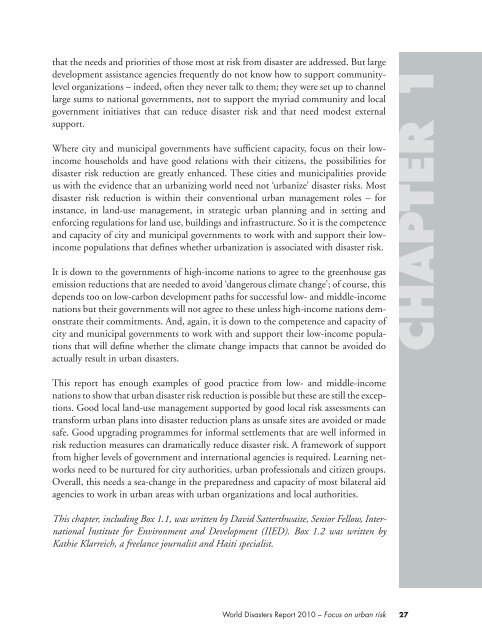World Disasters Report 2010 - International Federation of Red Cross ...
World Disasters Report 2010 - International Federation of Red Cross ...
World Disasters Report 2010 - International Federation of Red Cross ...
Create successful ePaper yourself
Turn your PDF publications into a flip-book with our unique Google optimized e-Paper software.
that the needs and priorities <strong>of</strong> those most at risk from disaster are addressed. But large<br />
development assistance agencies frequently do not know how to support communitylevel<br />
organizations – indeed, <strong>of</strong>ten they never talk to them; they were set up to channel<br />
large sums to national governments, not to support the myriad community and local<br />
government initiatives that can reduce disaster risk and that need modest external<br />
support.<br />
Where city and municipal governments have sufficient capacity, focus on their lowincome<br />
households and have good relations with their citizens, the possibilities for<br />
disaster risk reduction are greatly enhanced. These cities and municipalities provide<br />
us with the evidence that an urbanizing world need not ‘urbanize’ disaster risks. Most<br />
disaster risk reduction is within their conventional urban management roles – for<br />
instance, in land-use management, in strategic urban planning and in setting and<br />
enforcing regulations for land use, buildings and infrastructure. So it is the competence<br />
and capacity <strong>of</strong> city and municipal governments to work with and support their lowincome<br />
populations that defines whether urbanization is associated with disaster risk.<br />
It is down to the governments <strong>of</strong> high-income nations to agree to the greenhouse gas<br />
emission reductions that are needed to avoid ‘dangerous climate change’; <strong>of</strong> course, this<br />
depends too on low-carbon development paths for successful low- and middle-income<br />
nations but their governments will not agree to these unless high-income nations demonstrate<br />
their commitments. And, again, it is down to the competence and capacity <strong>of</strong><br />
city and municipal governments to work with and support their low-income populations<br />
that will define whether the climate change impacts that cannot be avoided do<br />
actually result in urban disasters.<br />
This report has enough examples <strong>of</strong> good practice from low- and middle-income<br />
nations to show that urban disaster risk reduction is possible but these are still the exceptions.<br />
Good local land-use management supported by good local risk assessments can<br />
transform urban plans into disaster reduction plans as unsafe sites are avoided or made<br />
safe. Good upgrading programmes for informal settlements that are well informed in<br />
risk reduction measures can dramatically reduce disaster risk. A framework <strong>of</strong> support<br />
from higher levels <strong>of</strong> government and international agencies is required. Learning networks<br />
need to be nurtured for city authorities, urban pr<strong>of</strong>essionals and citizen groups.<br />
Overall, this needs a sea-change in the preparedness and capacity <strong>of</strong> most bilateral aid<br />
agencies to work in urban areas with urban organizations and local authorities.<br />
This chapter, including Box 1.1, was written by David Satterthwaite, Senior Fellow, <strong>International</strong><br />
Institute for Environment and Development (IIED). Box 1.2 was written by<br />
Kathie Klarreich, a freelance journalist and Haiti specialist.<br />
<strong>World</strong> <strong>Disasters</strong> <strong>Report</strong> <strong>2010</strong> – Focus on urban risk<br />
27

















